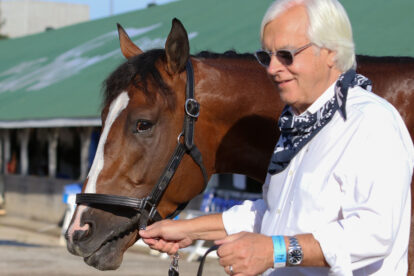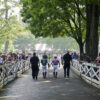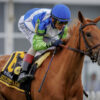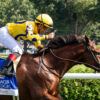In the aftermath of the 146th Kentucky Derby (G1), many handicappers, bettors. and horse racing fans were left scratching their heads. How did Authentic take the 15-horse field gate-to-wire to win the Run for the Roses in the seventh-fastest time ever for the iconic race?
Viewers’ eyes blinked in amazement as Authentic was collared at the top of the stretch by Tiz the Law, but despite setting a fast pace, he dug in and found a second wind that allowed him to begrudgingly pull away in the lane by 1 1/4 lengths.
Pedigree experts began thumbing through their progeny charts to figure out how a son of Into Mischief could excel going the daunting 1 1/4 miles of the American Classic; he had previously only sired graded stakes winners who topped out at 1 1/8 miles.
Those who follow the internal fractions of a race may say that it was impossible for Authentic (trained by two-time Triple Crown and six-time Kentucky Derby winner Bob Baffert) to go so fast early after leaving the outside post, and yet still have so much left in the stretch that he could re-rebreak under Hall-of-Fame jockey John Velazquez. Somehow, he held off the biggest Derby favorite in 41 years who had already won the Belmont (G1) and the Travers (G1).
The numbers don’t lie, and the fractions that Authentic set early and late tell the story. In recent years, horses have only wired the Derby after getting everything their own way on the front end, “walking the dog” through tepid early fractions.
As more and more speed horses scratched out last week (most notably Blue Grass [G2] winner Art Collector and Tampa Bay Derby [G2] victor King Guillermo), it became more likely that Authentic could set a slow pace and take them gate-to-wire for the win. It was unlikely that he’d set such a hot pace and keep going, though, as you can see in the race replay:
How unprecedented was Authentic’s accomplishment last Saturday? And how unlikely is it for any horse to achieve such a feat based on comparisons with recent other editions?
I’ll answer those questions in this 2020 Kentucky Derby Post-Mortem by systematically:
- Comparing Authentic’s fractional times to Monarchos’ in 2001, when he ran the all-time second-fastest Derby (only behind the great Secretariat)
- Comparing Authentic’s fractional times to those of War Emblem and Maximum Security, the two most recent horses to have taken the Derby gate to wire
- Comparing Authentic’s fractional times to Nyquist’s in 2016 to illustrate that this type of feat has been done before, but to also question the validity of such accomplishments under the long shadow of their trainers’ drug test violation history.
Sit back, relax, and maybe grab your favorite drink, because what you’re about to read will open your eyes and blow your mind.

1. Comparing Authentic to the Second-Fastest Derby of All-Time
When trying to comprehend just the greatness of Authentic’s feat, let’s start by looking at the top 11 fastest final Kentucky Derby times:

Amazingly, Authentic is now amongst the greatest names in the sport’s history. including Secretariat and Northern Dancer. He may even be sixth all-time because he’s only a millisecond behind Proud Clarion; they only used 1/5-second timing back in those days.
To dive deeper into the chart, let’s first compare Authentic to the fastest Derby this millennium and second-fastest on the list: Monarchos in 2001. Monarchos is much different than Authentic, though, because he closed into the fastest pace in Kentucky Derby history (as measured at the 1/2-mile and 3/4-mile points in the race).
In 2001, Songandaprayer blazed from the rail over a track condition labeled fast and set the early fractions through the first 3/4 of a mile before eventually fading to finish 13th. Congaree inherited the lead at the mile point and kept the pace moving into the stretch, but Monarchos charged from 13th early to take over in the middle of the track and drew off to win by 4 3/4 lengths.
Here’s Monarchos’ 2001 Kentucky Derby:
They flew early and Monarchos motored home late, so to see how Authentic stacks up against that fast race, here’s a comparison of the 2001 and 2020 fractional and final times:

The 2001 fractional times are the compilation of Songandaprayer, Congaree and Monarchos leading at the points described above. Since Authentic led at all points in this year’s Derby, every fractional time in the table is his.
Authentic was slower at all points in the race, but strikingly just 2 milliseconds slower at the mile point in the race. Authentic now has the third-fastest one-mile time in the history of the Kentucky Derby! That’s impressive.
The chart above doesn’t tell the whole story, though. Monarchos wasn’t running those fractional times early; he was far back by 16 lengths at the 1/2-mile point. Therefore, using a conservative estimate that 6 lengths is equal to 1 second, here’s an estimate of how fast Monarchos really ran throughout his race:

Comparing raw fractional times across decades is not an exact science, and the Churchill Downs track surface can change day-to-day, let alone decade-to-decade, but for demonstration purposes, the differences between raw times are glaring enough.
Authentic did all the “dirty work” himself, setting a fast pace and still holding on. Monarchos had the benefit of closing into the fastest pace ever and he would’ve been at least 9 lengths behind Authentic at the 1/4-mile point (based on Monarchos being an estimated 1.58 seconds slower). Authentic would’ve still been leading at the mile point by 0.36 seconds before getting passed and losing by about 3 lengths (0.64 seconds slower).
Is it more noble to do all the dirty work and hold off all comers (Authentic) than it is to benefit as a closer from a wicked-hot pace (Monarchos)? Even though Authentic ran 0.64 seconds slower than Monarchos, Authentic’s overall race may actually be more impressive.
Therefore, I could argue that Authentic – who was tiring at the end of his last win, the 1 1/8-mile Haskell (G1) – ran the second-greatest Kentucky Derby ever.
I know! It sounds crazy to say!
(I’m not even going to try to compare this year to Secretariat; that would be blasphemous)

(Note: Once again, comparing raw times over many decades is not an exact science, as the run-up distance was changed from zero to 34 feet starting in 2009. Also, track safety measures instituted that same year may have slowed down track times to reduce the likelihood of catastrophic breakdowns, in response to the filly Eight Belles’ death at the end of the 2008 Derby.)
2. Comparing Authentic to the Past Two Gate-to-Wire “Winners”
Comparing a pacesetter like Authentic to a closer like Monarchos is not apples-to-apples, so let’s look at the horses who led throughout and crossed their Derby finish lines first:

In 2002, another Bob Baffert trainee, War Emblem, was a 20/1 longshot who took the early lead from post 5 and never looked back, finding another gear in the stretch and drawing away over a track labeled fast.
War Emblem went a lot slower early than Authentic, though. By the 1/2-mile time, he was running 0.63 seconds slower, which extended to 1.52 and 1.68 seconds slower in the next two 1/4-mile splits. War Emblem sped up in the stretch to be only 0.52 seconds slower than Authentic at the finish, which would equate to about 2 1/2 lengths behind this year’s winner.
War Emblem has the 10th-fastest Derby time ever, but he ran faster late because he didn’t exert as much energy early. In fact, his 1/2-mile time is the 17th-slowest in the last 21 years.
Several people theorize that after having the fastest-paced Derby ever in 2001, the same jockeys were scared to go quick early the next year and let War Emblem get away easy:
Going back to the table above, it’s tough to compare this year’s Derby to last year’s for many reasons, but it does provide another data point to illustrate how a slowly-paced Derby would benefit a strong, lone leader.
Even though the 2019 Derby was run over a sloppy track and the horse that crossed the line first (Maximum Security) was disqualified to 17th place for interfering with horses in the far turn, he became only the second horse of this millennium to take the field gate-to-wire:
After setting an opening 1/4-mile pace that was 0.61 seconds faster than Authentic’s, Maximum Security slowed down significantly after that. He had plenty left despite the far-turn incident and re-broke in the stretch, but he was still a whole 3.32 seconds slower in the slop. That’s a difference of over 15 lengths, substantial enough despite the different surface types.
To punctuate this point, Maximum Security’s 3/4-mile time was ranked 20th-fastest in the last 21 years, compared to Authentic’s 3/4-mile time, the sixth fastest in that same timeframe.
Overall, Maximum Security went much slower, especially in the third-quarter of the race, which was the slowest on record since 1973.
The main point of these comparisons is to show how horses usually wire the Derby after setting slow paces and having plenty left late, but that’s not what Authentic did. He went fast early and still had another gear when he needed it in the stretch, so it makes his win that much more impressive.

3. Comparing Authentic to Nyquist in 2016
After proving how Authentic’s historic feat was unlike other gate-to-wire trips, my final comparison will show you that, compared to recent years, it wasn’t really that unprecedented.
Nyquist ran similar fractions in 2016 while sitting behind the fast pace of Danzing Candy, who like Authentic had to break from the outside post (20 in his year) and clear the field. Danzing Candy set the fifth-fastest 1/2-mile pace in the last 21 Derbies:
The below chart shows Danzing Candy’s pace before he faltered and faded after the 3/4-mile point, eventually finishing 15th. Gun Runner led at the mile point, while the final time belongs to Nyquist:

Nyquist was only 0.70 seconds slower than Authentic in the end. Since 2016 was the last time (until this year) that the track condition was labeled fast for the Derby, the conditions could’ve been somewhat similar (even though Nyquist’s race was in May and Authentic ran his in September).
Unlike Monarchos in the first comparison, though, Nyquist was always very close to the early pace, sitting second early and only falling as much as 4 four lengths behind Danzing Candy (it happened at the 1/2-mile point), so his estimated fractional times are very similar to the official ones:

Similarly, Nyquist and Authentic would only be separated by 2 milliseconds at the 1/2-mile point, but Authentic would eventually pull away to win by about 3 lengths.
Nyquist’s is closest comparison time-wise this millennium, so perhaps what Authentic did on Saturday isn’t so unbelievable if Nyquist’s win wasn’t a shock.
Additionally, Authentic has had four more months of development than any other Derby runner in history, so it isn’t out of the realm of possibility that the extra maturity could lead to a horse running this fast. The Derby has never been run this late in the year, so it makes sense that it’d be one of the best performances ever.
Right?

2020 Kentucky Derby Post-Mortem Conclusion
Comparing Authentic’s and Nyquist’s fractional times proves that the 2020 Derby performance was not completely out of the realm of possibility, but the similarities between them extend beyond pace numbers.
Both entered the race with pedigree questions. Sired by Uncle Mo, many questioned if Nyquist could handle the distance, but he answered emphatically with his decisive 1 1/4-length win over the late-charging Exaggerator.
Both trainers put stamina-building, one-mile works into their pupils just before the Derby; Doug O’Neill famously oversaw Nyquist’s memorable work at Keeneland one week before his victory.
Baffert gave Authentic a very aggressive work schedule at Del Mar, putting in four big works over a 23-day span that ended in a mile-long effort two weeks before the Derby and a strong 6-furlong move one week prior.
After Authentic won, Velazquez said, “Bob kept telling me to make sure I saved that last 1/8 of a mile. I want that 1/8 of a mile. He said, ‘I want you to hit left-handed,’ and he responded. It worked out the way we had planned it. Very proud of the horse.”
Baffert had a plan all along and did a masterful training job to get his colt ready for his biggest race.
Both Baffert and O’Neill needed to build stamina and overcome any distance limitations that their horses’ pedigrees could present. While they trained them hard on the track, some dubious questions remain.

There is a more ominous comparison between Nyquist and Authentic: both trainers failed recent drug tests before their horses’ big performances, violations that placed a great amount of doubt into many spectators’ minds regarding the legitimacy of these huge performances on the biggest stage.
In late May 2012, after two years of fighting the charges, O’Neill was found responsible for a horse showing excess carbon dioxide levels (called “milkshaking”), a violation that barred the trainer from horse racing for 45 days and came with a $15,000 fine from the California Horse Racing Board (CHRB). O’Neill had won the Kentucky Derby just a few weeks prior with I’ll Have Another.
In October 2014, O’Neill received a 45-day suspension and a $10,000 fine from the New York Racing Association (NYRA) as a result of a June 2013 violation at Belmont Park, and he received two additional 45-day suspensions based on his prior history.
By this point nearly six years ago, he had already accumulated 19 drug violations.
The point: people will question Doug O’Neill’s success until the end of time.
Before the 2016 Derby, O’Neill chose not to discuss “stuff that happened in the past that I didn’t do,” but also said, “Those times have made us – me – realize I need to step up my game and really make sure we’re on the same page.”

For Baffert, Justify‘s positive test for jimsonweed (said to be the result of contaminated feed) prior to the 2018 Santa Anita Derby (G1) tarnished his image.
Just this May, two of his top horses at the time (Charlatan and Gamine) tested positive at Oaklawn Park for excessive amounts of the painkiller lidocaine. Both were disqualified from their wins, including Charlatan in the Arkansas Derby (G1). Baffert has stated that the contamination came from the lidocaine patch that assistant trainer Jimmy Barnes wore while tending to the horses.
Unrelated, there was a historic FBI raid that happened back in March, just before the nation went on lockdown. Maximum Security’s trainer Jason Servis, as well as last year’s Derby results, become even more clouded. Servis was indicted on federal drug charges, and though it wasn’t proven that Maximum Security took any illegal drugs before the Derby, Servis was allegedly enhancing several of his runners during this timeframe.
There has been no evidence of Baffert having used any illegal drugs on this year’s Kentucky Derby winner, and I am in no way insinuating that he did.
I wish that we could all appreciate Authentic’s performance as an all-time great based on what the numbers tell us above, without any question of illegal drug usage looming over the story, but the trainers’ long shadows of drug violations put permanent doubts into bettors and fans alike.
These are simply the facts.









